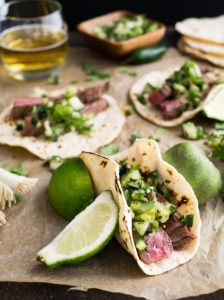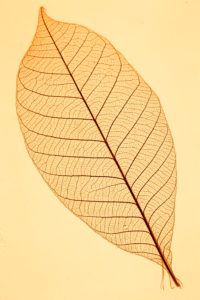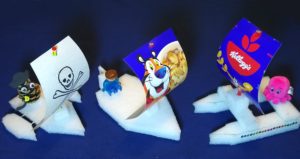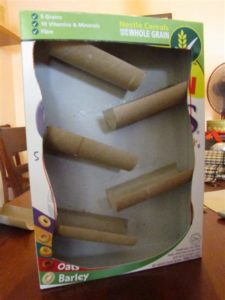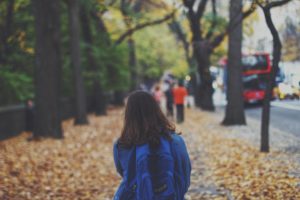sustainable brownie and Rainbow
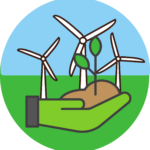
Sustainable Silchester has been working with the Silchester Brownies on a Sustainability badge suitable for Rainbows and Brownies. The badge is designed to be completed over 5 sessions during Unit meetings. It aims to introduce girls to four main areas of living more sustainably: food, environment, reducing waste and transport. Each girl has a worksheet, available by clicking on this link: Sustainable Worksheet, with some ideas for activities and space to keep a record of what they have done. After completing one activity in each of these four areas, the girls need to design a poster to explain what they have done and why and share it with the unit. On completion the girls earn a badge. We still have a few badges to give away to brownie units completing the challenge. Let us know via the Contact Us page.
On this page there are more ideas for each of the four activities and links to worksheets or further information. We also have a short section on home energy coming soon. Whilst an important part of sustainability, it doesn’t lend itself easily to group activity, so we have kept it separate.
We are very happy for any other unit to use our materials. Please share any other ideas of activities to meet our challanges, so that we can expand this page.
Sustainable Food
The key concepts for this section are:
- In order to have a nutritious diet – one that gives use the energy, vitamins and minerals that we need – it needs to be varied and include healthy food such as fruits and vegetables
- Eating locally means eating food that grows well nearby, so less energy is used to transport it to you
Grow Something that you can eat
Cress is quick, but how about considering pots of parsley, radishes or salad leaves? Thompson & Morgan have some suggestions for crops that can be started on windowsills and grown in containers.
Make sure that you use peat-free compost!
Cook a plant-based meal
Here are a few suggestions that don’t require cooking:
Think about Food Miles
Print a World Map and mark on the map where our food comes from.
How about New Zealand lamb, bananas from the Caribbean, rice from India, avocados from Mexico, vanilla from Madagascar? How does it get here?
What are some of the good things about being able to move food around the world (more variety, able to feed people during winter when less grows, or during a drought)?
What are some of the problems?
What grows well locally?
Can you make a poster of things that grow near here that we could eat more often?
The United States EPA has more suggestions on how you could approach this topic.
reduce, reuse and recycle
Here are some ideas for activities that you could do in your unit using bits and pieces that are lying around.
Make a Skeleton Leaf
A leaf skeleton is made when the soft tissue of a leaf has crumbled away, leaving behind the skeleton of veins. They are fascinating and very beautiful. Here is how to make your own leaf skeleton.
Fun Makes out of Bits and Pieces
Have fun making things out of scraps around the house. Technology For Fun and the Smallpeice Trust have some great ideas. We particularly liked:
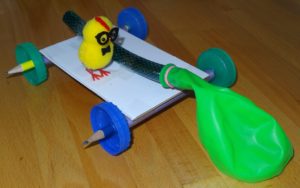
Balloon Car
Needs:
-
Corrugated cardboard
-
Thin card
-
plastic tube
-
4 plastic milk bottle lids
-
balloon
-
blu-tak/plasticene/playdough
-
2 round pencils
-
a ruler
-
some scissors
-
small rubber band
Marble Run
Needs:
- A cereal box or shoebox
- Sellotape
- Scissors
- Cardboard tubes (or cardboard you can roll)
- Paper
- Marble (or make your own)
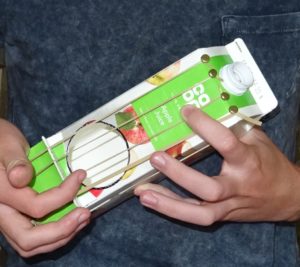
Juice Carton Guitar
Needs:
- 3 juice cartons
- 6 Elastic bands (about 12cm long and 1-2mm wide
- Nail scissors
- Large scissors
- Ruler
- Pen
We had fun making this Rubberband car (from the Smallpeice Trust suggestions)
environment
Insect Friendly Plants
The good news is that local insects tend to prefer local plants, so many plants that are good for your local minibeasts are also easy to grow. Many sites have lists of pollinator friendly plants like this from the Hampshire Wildlife Trust.
If you have the space, how about growing sunflowers? At the end of the season the dried sunflower head can be hung out for birds, who love the seeds.
Pot marigolds (calendula officinalis), lavender and cornflowers are also good.
Do you have anywhere around your unit where you could sow wildflowers?
Or if you want to get more ambitious try a mixed pot such as this

Make a Bird Feeder
Make a bird feeder to hang in your garden, and see how many of these garden birds you can spot.

Build a Minibeast Hotel
Build a minibeast hotel and give our struggling invertebrates somewhere safe to stay over the winter.
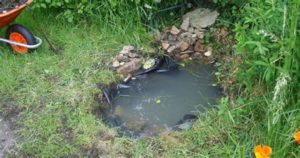
Make a Mini Pond
As you have probably heard on the news recently, one of the biggest things that you can do to help wildlife in your garden is to build a pond. Your pond doesn’t need to be big. A washing up bowl, or a large plant pot could be repurposed as ponds, providing you make sure creatures can get in and out. Here’s how you can build a mini-pond, even if you only have a small balcony or a tiny backyard.
transport
How did we get here this evening?
Can you work out the carbon dioxide generated by everyone coming here this evening?
- Assume walking and cycling are zero (this isn’t quite true, as there is energy involved in making the bicycle, and in extra energy expended in being active, if this is replaced by eating more).
- A bus ride is around 100g CO2 per mile.
- A car journey is about 200g CO2 per mile (remember to double the miles if the driver is doing a round trip).
- If the car is electric, then use 50g CO2 per mile.
For more types of transport use the interactive chart on our Travel page
How could we reduce this? Could we car share? Could we have a walk to Brownies/Rainbows week?

